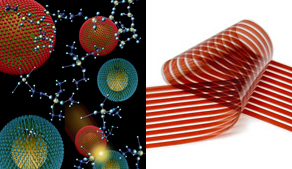
The idea of designing a cell to store energy was initially inspired by living cells. Energy produced and stored in a cell is thus comparable with that of a living cell. Daniel Morse from the University of California Santa Barbara is inclined to produce a photovoltaic cell that mimics photosynthesis mechanism in the cells of Sponges. Sponges, assemble complex nano-structured silicon materials (their skeletons) out of protein and seawater under conducive temperature and pressure. The process by which this is done is called Molecular Templating. Technology Review reported that “Morse and colleagues have made more than 30 types of semiconductor thin films and tested their photovoltaic properties. They are now working to incorporate the semiconductors into functional solar cells.”
How a Photovoltaic cell works:
When light hits the semi-conductor, the electrons in the outer orbitals are freed. These freed electrons travel through metal wires. The holes formed in the outer orbitals are filled by electrons from the same wires enabling the material to absorb new photons of light. This running around of electrons generates current. But the whole scenario depends upon the conductivity of the material. The more conductive it is, the harder it is to hold electrons in their positions; the less conductive it is, the more difficult it is to release the electrons from their orbitals.
In 1991, Michael Graetzel and colleagues developed what’s now called the Graetzel cell, which works like photosynthesis in plants. Graetzel cell is designed by coating ruthenium and organic bipyridine molecules on titanium dioxide nano-crystals frame-work. The entire set-up is placed in an electrolyte with iodine. An electrode fitted to be dipped in the electrolyte carries electrons to the molecular coating to fill up the orbitals. Unlike the semiconductors, this cell only allows the electron to jump to a higher orbital rather than getting freed.
Though these cells are not as efficient as silicon solar cells, ita€™s designing cost is much cheaper. Besides, combining it with organic-solar cells is expected to make it 20% more efficient.
via : Worldchanging




